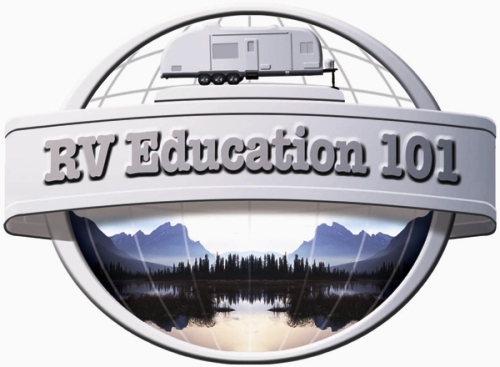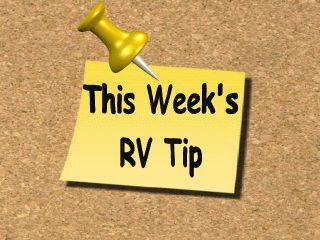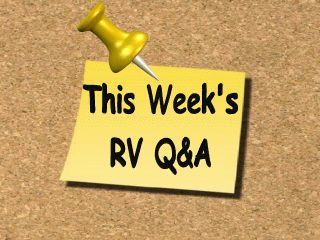RV University This Week 8/31/2009
- Monday, August 31 2009 @ 02:53 pm UTC
- Contributed by: RVED101


RV University this Week
Your weekly source for interesting
RV articles, tips, tricks, video clips and advice

RV Education 101
U of RV Journal #31- August 31, 2009

“The real voyage of discovery consists not in seeking new lands, but in seeing with new eyes."
- Marcel Proust, French novelist

BY MARK
Hi Everybody,
Well, one of our last summer RV trips is over Labor Day weekend. As usual we can't wait to hit the road. If you plan to be on the road over Labor Day stay alert and drive defensively. I'm sure there will be lots of traffic on the roads.A few weeks ago I was contacted by a very nice individual whose name is Jose Adauto de Souza. Adauto lives and works in Brazil. He is a Petroleum Geologist/Geophysicist and is close to being retired. Since 1978 he has been a camping enthusiast, starting with tents, then a pop-up, travel trailers and now has a Class A motorhome. I have been through the same RV progression, and around the same time frame as Adauto.
Click here to see Adauto's motorhome
He is a member of a regional RVing group in Rio de Janeiro State called "Amigos do Rio RV Group (Rio's friends) (Brazil)". Over the last year Adauto has been researching and compiling free RV information for other RV enthusiasts in Brazil, since they do not have a bibliography about RVing in Brazil. He was working on a trailer sway article when he contacted me, to help educate some of the RVers in his group on sway issues. He wanted to know if I would be interested in working together with him on the article. At times it was a bit difficult to translate what each of us were saying to each other, but I think we figured it out in the end.
This week's feature article is our combined effort titled, "Trailer Sway, what it is & how to control it". So, if you own a trailer, or if you're just curious about trailer sway be sure and check it out. I divided the article into two parts, and will include part two in next weeks feature article.
Until next week happy camping & safe travels
Mark

Trailer Sway, what it is & how to control it Trailer sway, that side-to-side fishtailing movement, occurs when there is a force perpendicular to the tow vehicle and trailer trajectory, applied to the hitch ball. An important factor in controlling sway is the amount of tongue weight applied to the hitch ball, and how that weight is distributed to the tires on the tow vehicle. A general rule is . ....... Read the article
Check out this week's poll: "Do you use the shower at the campground bath-house more than the shower in your RV?" To participate in the poll, look on the left hand column (here at RV University) towards the top

RV parks roll out on-site dining
Jim King and his traveling companion, both of Daytona Beach, Fla., were hot, tired and grubby from a long day of sightseeing in and around St. Louis, Mo. When they returned to their 40-foot motor home at Sundermeier RV Park in St. Charles, they didn't feel like fixing dinner, nor did they feel like cleaning up to go out to eat.....
CEO Interview: Winnebago's Olson sees RV market expanding to younger buyers
That's the reason why we are looking at something other than just a conservative type RV......

BY Mark Polk
Tip #1 Over time grease and residue builds up in the gray tank and it causes a foul odor, not to mention how it is affecting the tank and valve assembly. Periodically treat the gray tank with environmentally safe holding tank chemicals to avoid odors from the tank. When the tank is empty you can also add some dishwashing liquid down the drains to help break down grease and residue build up.
Tip #2 Poor emissions and/or a faulty oxygen sensor can cause a 40% reduction in fuel economy. Can you believe that? A 40% REDUCTION!

...with Mark
Q.
I am trying desperately to find information on popup camper tires, and all I'm getting is conflicting information. I am the proud owner of Pop Up 101 DVD and have watched it many times as I am still learning the ins and outs of pup ownership. I hope I can get some solid information from you because if anyone would be knowledgeable on this topic, it would be you.
Here's my situation. I've had my 2007 Fleetwood Yuma out 3 different times in the past year and everything was beautiful. I am planning my next trip in a few weeks and since the popup has sat for an extended period, I checked the tire pressure on both tires, one was 50 psi and the other was 48 psi. I checked the sidewalls and was stunned to see 80 psi listed. I checked my notes taken at the dealership and it stated 65 psi cold tire pressure. And that is the pressure I had run the tires on for the 3 trips. So I called the dealership and the parts man said the correct tire pressure was indeed 80 psi. This is also what it says on the sticker on the camper. So I inflated both tires to that pressure with my portable inflator. Within an hour, one of the valve stems blew. I've had that replaced, but now I'm rather concerned that I ran these tires at 65 psi for the first 3 trips. (The total mileage is less than 300 miles). I've asked for input on several forums and have gotten answers "from no big deal to buy new tires and rims".
One of the more logical solutions was to take all 3 tires in and have high pressure stems put in. However, a few folks said I might have serious internal damage on 2 of the tires. The spare is still brand new and unused. Another poster said if the popup wasn't weighed down to the max, the tires are probably just fine. Very confusing!!!!
The tires are 5.30 X 12 Loadstar with a Load Range of 1045 lbs. My Yuma has a Gross Vehicle Rating of 2400 lbs. so one person said that tires were all wrong and I needed at least a Load Range of 1200 lbs. I thought that rating was for the axle and not for half the weight of the popup. I can't imagine Fleetwood putting completely inadequate tires on this unit.
From what I've read, overloading one's camper is one of the biggest reason for tire wear and failure along with the underinflated tires. I sincerely feel the popup was NEVER overloaded. I haven't had the TV and camper on scales yet. And I know everyone says they are within the weight restrictions, but I know I am well within the weight restrictions as I travel VERY light. There is no water, LP gas, bikes, food, etc in the camper. The only items in the camper are a sleeping bag, extension cords, a broom and paper plates, knives, forks and spoons, a toaster, coffee maker and small fans. The popup does have AC and I've calculated this weight into the overall weight of the camper, but I am most definitely below 2000 lbs. The popup tows like a dream, I could hardly tell I was towing anything. Additionally, there is no sway and braking is just as smooth as could be. I understand, now, that the tires were underinflated, but I found a chart that showed you could tow at a load range of 815 lbs. at 65 psi with this tire. I'm new at this and VERY CONFUSED!!!
So, in conclusion, could you give me your opinion on this. I am very surprised that more detail isn't offered to new popup owners when it comes to tires. I have learned over the past few days how crucial this knowledge is, but getting cold, hard facts is proving to be difficult. I would truly value your opinion. Tire Care and Maintenance 101 would be a great DVD.
Mark Says:
First of all I don't want to alarm you or make you feel as though there are major problems with your tires. Unless you load your pop up to the maximum GVWR of 2,400 lbs the tires are probably okay, but I want to try and explain some of your concerns.
The general rule is that tires on a vehicle are rated to handle the Gross Vehicle Weight Rating (GVWR) of the vehicle, less the hitch weight. The GVWR is the maximum amount of weight the axle and tires are designed to support. In your case, with one axle, each tire should be capable of supporting 1,200 pounds, with two tires being equivalent to the 2,400 lb. GVWR. This would also depend on how the weight in the fully loaded trailer is distributed.
Let's use tires rated for 1,200 lbs as an example for one minute. If you weighed the pop up with both tires on the scale and the fully loaded trailer weighed 2,300 pounds (100 lbs below the GVWR)you would be under the impression that all is okay. Now, let's say you weighed it by individual wheel position and realized on one side of the axle there was 1,300 pounds resting on the tire and on the other side there was 1,000 lbs. on the tire. The side weighing 1,300 lbs. would be overloading that tire by 100 pounds even though you didn't exceed the 2,400 lb. GVWR of the pop up.
Now, in reality your pop up has an approximate dry weight of 1,650 lbs. If the tires on the pop up were rated to support the 2,400 lb GVWR this means you could potentially load 750 lbs. in it before you exceed the 2,400 lb. GVWR. However, your tires are rated to support a total of 2,090 lbs. (if the weight is distributed properly) which means you could potentially load 440 lbs. before you exceed the tire ratings. With your current tires the GVWR for the pop up cannot exceed the 2,090 pounds.
So basically if you are not adding more than 440 lbs. in the pop up, and the weight is distributed from side to side and front to rear, the tires can support the load.
Now let's talk about inflation pressure. Somewhere on the pop up there is a trailer placard. It should be close to the Federal certification label on the front left side of the trailer. The trailer placard will provide tire and loading information. Tire inflation pressure is always based on the load the tires are carrying. The maximum tire pressure is what you see on the tire sidewalls. So in your case if the trailer were fully loaded to the maximum weight the tires can support they would need to be inflated to 80 psi. If there is less weight on the tires the inflation pressure is lower. This may be where the 65 psi came into play.
I looked and looked for the load and inflation charts for Load Star tires, but couldn't find it. Manufacturers publish these charts to show how much air pressure is required to support a certain load on the tire, so the consumer knows how much to inflate the tires based on the current load.
In a perfect world the tires on the pop up should be able to support the 2,400 lb. GVWR of the trailer. The problem as I see it is Fleetwood used 12 inch tires on the Yuma and the highest rating for 12 inch tires was 1,045 lbs. The interesting thing is when I looked at the 2009 models the Yuma shows 13 inch tires which are rated to support the GVWR. I don't know why they didn't do it in 2007.
I'm sure the tires themselves are okay, but you will need to watch the loads. The only way to know for sure is to take the loaded pop up to a set of scales and weigh it, preferably by the axle weight and by the individual tire positions.
I wrote to Fleetwood customer service to see what their response is, but haven't heard as of yet.
I hope this helps explain some of your questions
 Let RV Education 101 help you save money in 2009
Let RV Education 101 help you save money in 2009
RV Buyers Survival Guide
Book By: Bob Randall / Published and Edited by RV Education 101
The all new THIRD Edition of the RV Buyers Survival guide. Edition 1 sold out over 10,000 copies in just 18 months and helped thousands of RVers save big on inflated asking prices. The two or so hours of reading will enlighten you to the ins and outs of the RV Buying process. A process who's "insider secrets" have been closely guarded until now. You'll build your confidence by understanding both how to properly shop for an RV, how to negotiate by being able to calculate the dealers actual cost factors, and how to control the sales process. Armed with this information you'll be able to join Bob's swelling ranks of readers who have saved thousands of dollars on their purchases. Many happy readers have said that the "RV Buyers Survival Guide" was the best investment they made in owning an RV.
.
Length: 100 pages
sale price: $17.00
General and Unsubscribe Info

About us:
Our goal with RV University This Week is to provide you with helpful information to make all of your RV experiences more enjoyable. I left my position as an RV Sales and F&I manager in 2000 to start my own company, RV Education 101. We produce educational videos, DVDs and e-books on how to use and maintain your RV. The reason I left my job was due to my concern about the lack of educational and safety awareness material available to the RV consumer, in other words, you. We are a small company. My wife Dawn left her position in RV sales to help start the company and is our Sales and Marketing Director. We currently have a 35-foot Class A motor home. We have two boys, Tyler 12 and Josh 18, both avid RVers and two dogs, Gracie and Buck. Gracie is the good one. If you would like to learn more about us and RV Education 101 feel free to visit http://www.rveducation101.com
RV University This Week © Copyright 2009 Mark J. Polk, except where indicated otherwise. All rights reserved worldwide. Reprint only with permission from copyright holder(s). All trademarks are property of their respective owners. All contents provided as is. Advertisers are solely responsible for ad content.
To contact us with feedback or questions, email to: info@rveducation101.com
To subscribe, please go to: http://rveducation101.com/email/
To unsubscribe, please go to: http://rveducation101.com/email/unsubscribe.asp
RV Education 101 Newsletter is an opt-in ezine available by subscription only. We neither use nor endorse the use of spam. Your email address will ONLY be used to distribute this newsletter and will NEVER be sold or given to any other entity!!
Happy Camping,
Mark & Dawn
RV Education 101
3969 Stedman Cedar Creek Road
Fayetteville, NC
28312
910-484-7615
Copyright 2009 by RV Education 101












